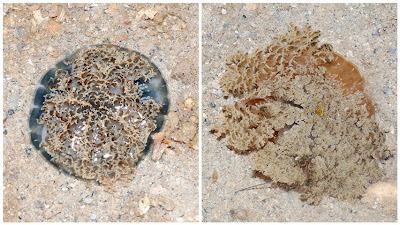It's the monsoon season where it will never fail to rain in the afternoon. Nevertheless, the Teamseagrass folks continued with our seagrass survey behind the dark clouds.
Before we started, Nor Aishah gave us a detailed introduction of the scientific methods in carrying out the transect and showed us how to identify the different species of seagrass.
The seagrass meadow in Semakau is among the richest on our shores with corals growing among the blades of green.
After a smooth monitoring session with Hazwani, we went to the rocky shore in front of the mangroves to have a quick look. It has been a long while since I had a look at the northern shore.
I found this really long sea cucumber from beneath a rock. It does look like a paler version of the Black long sea cucumber (Holothuria leucospilota).
Here's a closer look at the tube feet and feeding tentacles of the sea cucumber. Not too sure of its identity though.
It was great to find the Cryptic sea stars (Cryptasterina sp.) on Semakau again! The mottle coloration on its surface serves as an excellent camouflaged when they are found underneath rocks.
As the tide went low, I went over to the reef edge to check out how it is doing. Surprisingly, there isn't too much of a Sargassum seaweed bloom on the Semakau shore, thus revealing the sponges and hard corals such as this Cauliflower coral (Pocillopora sp.).
The Polka-dot nudibranch (Jorunna funebris) were easily sighted throughout the trip.
Another nudibranch sighted during the trip was this Black phyllid nudibranch (Phyllidiella nigra).
The black-mouth cerianthid (Order Ceriantharia) is more commonly seen on our southern reefs than on the northern shores.
Looking like anemones, the branchy parts of this animals are actually the arms of the Upsidedown jellyfish (Cassiopea sp.). These jellyfish prefer to be upside down as their frilly arms harbour symbiotic algae that undergoes photosynthesis and shares the food produced with the jellyfish.
The Teamseagrass people were not alone! Another group on the Semakau shore consisting of the RMBR volunteers were around for a guided walk with their guests.
Many of these Knobbly sea stars (Protoreaster nodosus) have once again moved... this time slightly northwards.
Not sighted for a long time, this unidentified Fine-lined flatworm seem to be in season as a few of them were found on the reef. It's a special find for me!
Another pretty flatworm that we encountered would be this Persian carpet flatworm (Pseudobiceros bedfordi).
The RMBR volunteers found two new giant clams on the shore! Two different species somemore! The first one is a juvenile version of the Fluted giant clam (Tridacna squamosa) with green photosynthetic algae on its mantle.
The top find of the day would be this small Burrowing Giant Clam (Tridacna crocea)!
It's the first time seeing a crocea with neon electrifying colours in our local waters! :) I was really excited to see this. Thanks Luan Keng for sharing with me the clammy finds.
I shall end off this post with a photo of two unknown individuals (for you to guess who) who willingly posed with their mosquito gear.
Thank God for the trip with only a bit of rain.... it was great that we could all survey and enjoy the shore on this trip to Semakau.
More photos of the trip here: http://www.flickr.com/photos/koksheng/archives/date-taken/2012/11/13/

























1 comment:
That burrowing clam is pretty awesome. It's great following your adventures through these marvelous pics.
Post a Comment